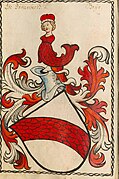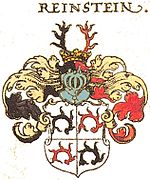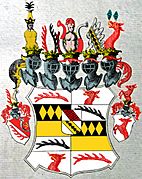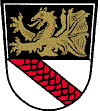Tattenbach (noble family)

The Tattenbach family (also Tettenbach , later Reinstein-Tattenbach ) were an old Bavarian aristocratic family , Catholic denomination, which played an important role in Bavaria from the Middle Ages to the beginning of the 20th century and owned properties throughout the German-speaking area.
history
Name and origin
The Tattenbach family were an old Austrian noble family that initially appeared as the Tattenpeck family and that came to Lower Bavaria in the Middle Ages . The family line begins around 1280 with Otto Tattenpeck , now in a different spelling Tattenbach. His son Ottokar is named in 1310 as the lord of Tattenbach and Lichtenau . At that time it was based in Tattenbach Castle near Bad Birnbach in the Rottal-Inn district . Instead of their castle, which no longer exists, the place names Ober- and Unter-Tattenbach still exist today . In 1598 they received the dignity of the noble lords of Ganowitz and in 1623 the imperial baron status .
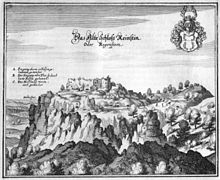
With Count Johann Ernst von Rheinstein, this old dynasty of counts went extinct in 1599. The possession Rheinstein, Reinstein, or later written as Regenstein , in the Harz Mountains then fell back to the Halberstadt diocese . From this, after several changes of ownership, the Tattenbachs took over the county as a fief by name in 1643, from then on they called themselves Counts of Reinstein-Tattenbach . The title of Earl of Valley was granted in 1656.
Division into lines
Ottokar von Tattenbach, mentioned in 1310, was the great-grandfather of Ortolph von Tattenbach, who in turn was the grandfather of Hans von Tattenbach, who served as a knight, imperial councilor, colonel in Croatia and captain zu Gurk in Carinthia . One of the descendants of this knight Hans von Tattenbach was Baron Sigismund von Tattenbach, with whose three sons, who were raised to the rank of count in 1637, the sex was divided into three lines: an "older Bavarian", a "younger Bavarian" and the "Vogtland" Line.
- The older Bavarian line goes back to Johann Christoph von Tattenbach. He left three sons, of which the middle one, Wilhelm († 1661), achieved great importance. Wilhelm was royal and imperial privy councilor and grand prior of the Order of St. John . From Archduke Leopold Wilhelm in his function as Bishop of Halberstadt, he received the imperial count of Reinstein, seat and vote on imperial and district assemblies, as well as the exercise of the right to mint in 1644 . His numerous possessions in Lower Styria (today Slovenia ) and in Silesia passed to his nephew Gotthard after his death, and then to his eldest son Johann Erasmus . Johann Erasmus was involved in the magnate conspiracy against the emperor and was beheaded in 1671, the property in Slovenia and Silesia was confiscated. The county of Reinstein (Regenstein) subsequently fell to the Elector Friedrich Wilhelm of Brandenburg . From 1673, the older Bavarian line still had a seat in Baumgarten (Rottal-Inn district) not far from the original Ober- and Untertattenbach. It went out with the death of Josef Ferdinand von Reinstein-Tattenbach, Count of the Holy Roman Empire , Count von Valley, Baron zu Ganowitz (Gonowitz), Bavarian Colonel-Hofmeister and Minister, on November 19, 1802.
- The younger Bavarian line goes back to Wolfgang Friedrich von Tattenbach. She was one of the largest landowners, especially in the Innviertel , where she owned 14 of the 88 lordships there in 1779. Johann Adolf Freiherr von Tattenbach was probably not very popular as a peasant smuggler with his subjects, as they set fire to his castle in St. Martin im Innkreis twice in 1626. In contrast to his father, Gottfried Wilhelm Reichsgraf von Tattenbach is described as a mild gentleman. His son Ferdinand Josef Graf von Tattenbach was shot by hired murderers in 1712. This line of the family went out with the Bavarian treasurer Heinrich on October 3, 1821. He left behind a huge property and estates, including Valley in today's district of Miesbach , St. Martin im Innkreis , Maxlrain in the district of Rosenheim and Adldorf (until 1802 to Baumgarten belonging, inherited from Josef Ferdinand von Tattenbach). On the basis of his will, these estates fell to his nephew Maximilian von Arco , who was ultimately also able to combine the properties of the other lines, to which the court brands such as Zell in Niederbayern , Falkenberg Ndb. and Malgersdorf belonged. His descendants still live in the castle in St. Martin im Innkreis and own the estates Valley, Adldorf and Baumgarten.
The New Castle in Valley , Upper Bavaria
Adldorf Castle , Lower Bavaria
Baumgarten Castle , Lower Bavaria
Sankt Martin im Innkreis Castle , Upper Austria
Maxlrain Castle , Upper Bavaria
- The Vogtland line founded Gotthard, she was based in Geilsdorf , community Weischlitz , this line is not extinct. The moated castle built by the Counts of Tattenbach was no longer inhabited from 1866. This line includes Johann Ludwig August Franz Wilhelm, Count von Tattenbach (born September 26, 1816), Bavarian Chamberlain and Colonel. Further descendants of this line can be found as high-ranking soldiers and diplomats of the Kingdom of Bavaria .
Ruins of Geilsdorf Castle , Vogtland
Significant people
- Christian von Tattenbach (1846–1910), German diplomat
- Franz von Tattenbach (diplomat) (1896–1974), German diplomat
- Franz von Tattenbach (Jesuit) (1910-1992), German Jesuit
- Georg Ignaz von Tattenbach , sergeant general of Elector Maximilian II. Emanuel in Braunau am Inn
- Hans Erasmus von Tattenbach (1631–1671), participant in the magnate conspiracy
coat of arms
development
Family coat of arms of those of Tattenbach in Scheibler's book of arms
Coat of arms of the Lords of Trenbach in Johann Siebmacher's coat of arms book, 1605
Coat of arms of those of Tattenbach after Johann Siebmacher
Family coat of arms of the Counts of Reinstein with the stag sticks, Johann Siebmacher , 1605
The family coat of arms represents an inclined, red, roughed bar that is leaned against it. A jewel on the shield. An armless, blonde mermaid with a red headgear and a red fishtail. In the vast majority of depictions, this mermaid is positioned between two large cattle horns with a mouthpiece. Trenbach coat of arms : The von Tattenbach inherited in 1567 through marriage, the coat of arms of those of Trenbach . There is a wonderful variant of this in the coat of arms of the Churbayrian nobility (Image 57). It shows the quartered shield, in two diagonally opposite quadrants a bird of prey with a gold rod in its beak is shown. The other two quadrants come from an inherited coat of arms of the noble family of Intobler . The shield is again divided horizontally, the lower surface is colored golden, in the upper black half there are three golden diamonds vertically. Gem: Above it are two crowned helmets, two helmets, from one crown this griffin grows again with a golden fork in its beak. The respective tips end with a crown in which a peacock feather (eye) is. In the other crown (intobler helmet) is an armless male figure, in some depictions and descriptions it is a Moor in a golden robe. The brim of the hat is again set in black with three golden diamonds. The pointed hat itself is golden again and closes with a small crown in which six black cock feathers are stuck in other depictions and alternating black and gold feathers. Secondary coat of arms; in some versions these are also incorporated into the main coat of arms. On the left is the Reinstein coat of arms . It shows a diagonally divided shield. In the upper red area is a silver hunting horn, below a red deer pole with an ear. This coat of arms was used especially by the older line, so the stag rod is incorporated into the coat of arms of Bad Birnbach. The small one on the right shows a wolf jumping up, it is the coat of arms of the extinct family of the Resch von Grasensee . Both coats of arms are crowned, the gems on the coat of arms each show the symbols of the shield. All these elements are united in the late coat of arms after 1750. Another shield with a helmet is also integrated here, a slanting golden bar studded with black iron hats in a row.
Afterlife in municipal coats of arms
While the typical sloping bar from the Tattenbach family coat of arms is incorporated into the municipal coats of arms of Bayerbach and Malgersdorf, the coat of arms of Bad Birnbach shows the stag bar from Reinstein's coat of arms.
Coat of arms of the municipality of Malgersdorf
Coat of arms of the municipality of Bayerbach (Rottal-Inn)
Bad Birnbach market
See also
literature
History of the Tattenbach family
- Franz Menges: Tattenbach, barons and counts of. In: New German Biography (NDB). Volume 25, Duncker & Humblot, Berlin 2013, ISBN 978-3-428-11206-7 , p. 796 f. ( Digitized version ).
- Gabriele Greindl, Bettina Dankesreiter: Tattenbach, noble family . In: Historisches Lexikon Bayerns , published on February 26, 2016.
- Article Tattenbach, Barons and Counts of . In: Carl dirt : Historical topographical Lexicon of Steyermark , Vol. 4: Si - Z . Andreas Kienreich, Graz 1823, p. 159.
To the coat of arms of the Tattenbach family
in chronological order
- Johann Franz Eckher von Kapfing and Liechteneck : Book of arms of the Bavarian nobility , manuscript Cgm 2270 from 1693 in the Bayerische Staatsbibliothek, p. 112 ( digitized version of the Bayerische Staatsbibliothek).
- Book of arms of the Bavarian nobility , manuscript Cgm 1511 from 1808 in the Bavarian State Library, vol. 2, p. 14 ( digitized version of the Bavarian State Library).
- Konrad Tyroff : Book of arms of the entire nobility of the Kingdom of Bavaria . Verlag des Wappen-, Kunst- and Commission-Bureau, Nuremberg 1819.
- Martin Carl Wilhelm von Wölckern : Descriptions of all coats of arms of the princely, counts, baronial and aristocratic families living now in the Kingdom of Bavaria. Designed according to heraldic rules . Part 2. Tyroff, Nuremberg 1827.
Web links
Tattenbach ( Memento from May 21, 2010 in the Internet Archive )
- Bohemian nobility (PDF; 1.4 MB)
- Moravian nobility
- Sankt Martin im Innkreis
Individual evidence
- ↑ Entry about St. Martin im Innkreis on Burgen-Austria
- ↑ Bad Birnbach: Wappengeschichte ( Memento of the original from June 30, 2009 in the Internet Archive ) Info: The archive link was inserted automatically and has not yet been checked. Please check the original and archive link according to the instructions and then remove this notice.






